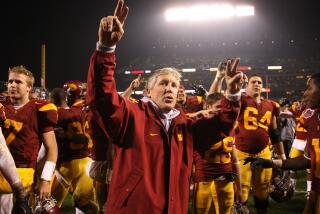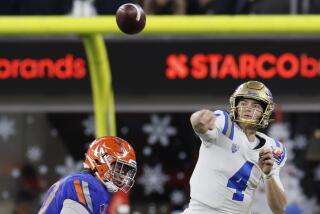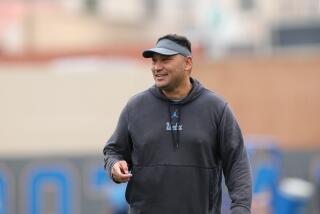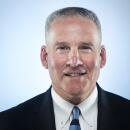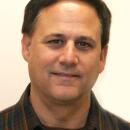Cardinal Rule Is What UCLA Now Must Follow
UCLA cornerback Matt Ware cannot go anywhere in Southern California without seeing reminders.
After years of low visibility, it seems as if cardinal-and-gold clothing proliferates. Even at UCLA’s training camp.
“It’s funny how before, people weren’t proud to wear the SC shirt,” Ware said lightheartedly. “Now, it’s everywhere you go. We had a guy out here at practice today wearing an SC shirt. That’s kind of bold.”
These are heady days for USC fans. Another Heisman Trophy, an 11-2 record, an Orange Bowl victory and a No. 4 ranking in the final polls last season made Los Angeles the Trojans’ town once again.
“A lot of people who live in this area and grew up in the ‘60s, ‘70s and early ‘80s understand that feeling -- it’s back,” said Sam Cunningham, an All-American fullback for the Trojans in 1972.
But not so long ago, a mere two seasons to be exact, USC was right where UCLA finds itself today: With a new coach intent on returning an underachieving program to glory.
“They’re similar situations,” said USC Coach Pete Carroll, who succeeded Paul Hackett after the 2000 season. “People [at UCLA] are disappointed and there’s frustration and all that. It’s a real classy program, a place that’s used to being up.”
In at least one sense, Carroll’s task was probably less daunting than that faced by new UCLA Coach Karl Dorrell.
When Carroll, who had coached two NFL teams, took over USC’s program, UCLA was two years removed from consecutive 10-2 seasons. The 1998 “Meltdown in Miami” that ended their flirtation with a national championship sent the Bruins spiraling toward mediocrity. They were coming off 4-7 and 6-6 seasons.
It’s tougher timing for first-time head coach Dorrell and his mostly new Bruin staff. They must revitalize the program at a time the Trojans are experiencing success and popularity reminiscent of the ‘60s and ‘70s, when they won four national titles.
Like it or not, everything blue and gold is colored by cardinal and gold. Every bit of forward progress seems puny compared to the giant steps taken at USC.
The challenge for UCLA is greater than taking the program beyond where former coach Bob Toledo left it, a comfy but unremarkable place where 7-5 records and lower-end bowl games were the norm. The challenge is reaching -- and eventually eclipsing -- the level of the Trojans, who are ranked eighth and are favored to win the Pacific 10 title.
“USC has obviously done very, very well and Coach Carroll is an excellent football coach,” Dorrell said. “But I can’t concern myself with them right now because there are so many things for me to put in place that I only can really control what I can control.
“There’s a time where we’ll have to line up at the end of every year and see how we measure up with where they’re at.”
USC returned to prominence after nearly two decades of occasional but unsustainable success. For most of the 1980s and ‘90s, USC did not come close to meeting the standard that alumni and fans expected after their school’s run during the ‘60s and ‘70s.
“I kept thinking, ‘Well, next year, next year,’ ” said Hal Bedsole, an All-American end for the Trojans’ 1962 national championship team. “All of sudden you go, ‘Well, wait. That’s like five next years in a row,’ and I realized we were not an elite program anymore.”
Carroll’s mission to restore USC’s winning tradition began in December 2000, after 6-6 and 5-7 seasons under Hackett. USC had not been ranked in a final Associated Press poll since the 1995 season, when the Trojans were 12th and had made their only Rose Bowl appearance during the 1990s.
As he scripted an afternoon practice in the newly remodeled Trojan football offices, Carroll, 51, grinned while remembering the initial days after he was hired. Many longtime USC fans and observers were skeptical that Carroll, who had neither played nor coached as an assistant at USC, could turn around the program.
“It was like I was going into a lion’s den,” he said.
Carroll, who had coached the New York Jets and the New England Patriots, retained two full-time members of Hackett’s staff and hired seven assistants, among them offensive coordinator Norm Chow. Holdover defensive line coach Ed Orgeron was named recruiting coordinator.
“From the moment Coach Carroll got here, things changed,” senior cornerback Marcell Allmond said. “Our workouts, practice schedule, how the coaches focused on certain things. It was the same exact team, but a different approach.”
USC won its first game under Carroll in 2001, then lost four before splitting its next two.
“I questioned whether we were doing it the right way -- there were things that needed to be fixed,” he said. “We weren’t on a very good track for a while.”
On Oct. 27 at Arizona, USC cornerback Kris Richard returned an interception 58 yards for a touchdown with less than two minutes left to give the Trojans a 41-34 victory. It was a pivotal moment in the season and the turnaround.
“We had made the play we needed to make to win in a critical situation,” Carroll said. “When you look back, that’s when it happened. That locker room is where we said, ‘We don’t have to lose anymore,’ and it’s kind of held up.”
USC is 15-3 under Carroll since that Arizona victory, and has beaten UCLA twice.
“We work really seriously -- nose to the grindstone, the whole thing -- and also shift gears and have a lot of fun doing it,” Carroll said. “I really work to create an environment where people do things because they want to, not because they have to. I think there is a tremendous distinction in the productivity when it’s that way.”
Success on the field has carried over to the living rooms of high school players. For the second straight year, with Orgeron and Carroll leading the way, USC landed one of the nation’s top recruiting classes.
“At first, when we went to homes, we had to sell our plan,” Orgeron said. “We had to make them believe in us and what we were going to do. Now, we say, ‘Hey listen. This is what we said we were going to do, and we’re doing it. Come join us.’ ”
Dorrell, 39, is working toward a similar pitch while attempting to restore UCLA’s program to the status it enjoyed when he played wide receiver for Bruin Rose Bowl teams in 1982, ’83 and ’85.
From 1982 to 1998, UCLA was ranked in the Associated Press final top 10 seven times, more than any other school in the Pac-10. From 1991 to ‘98, the Bruins beat USC eight consecutive times, the longest winning streak in the series.
But UCLA has lost four in a row to the Trojans, and last season’s 52-21 rout probably sealed Toledo’s fate. The Bruins have been to the Rose Bowl only twice since Dorrell’s final season as a player in 1986.
Dorrell, who worked as an assistant coach at six colleges before joining the Denver Broncos’ staff, said Carroll’s success at USC gave him confidence that a quick improvement is possible at UCLA.
“It’s more an issue of trying to raise the bar,” Dorrell said. “That’s really what this is all about.”
So far, so good, according to Bruin players who are preparing for their opener Sept. 6 at Colorado.
“He’s setting a new standard for us,” senior defensive tackle Rodney Leisle said.
Said Ware, “There’s an energy out here that’s just present all the time. You can tell during practice. It’s almost game speed every time. That’s something we’re going after.”
New Bruin coaches also are aggressively pursuing recruits. Eric Bieniemy and Jon Embree, in particular, have brought a take-no-prisoners approach that complements the solid efforts of holdover assistants Gary Bernardi, Mark Weber and Don Johnson.
For now, the coaches consider it a personal affront to the Bruins every time a top Southern California recruit chooses USC over UCLA.
“The way you get it turned around is by saying, ‘SC can’t take them all,’ ” Bieniemy said. “You just have to have the attitude that we are a great school. This school here has a lot of tradition, a lot of history about it that can make it appealing. Then you go out and aggressively recruit kids.
“You don’t necessarily tell them what they want to hear, you tell them about the direction you are going.”
Orgeron, USC’s recruiting coordinator, expects the battle with the Bruins to become more intense.
“A program like UCLA can bounce back, with the right people, like that,” he said, snapping his fingers. “It’s just a matter of doing the right things, like Pete did. We did it here.”
*
Staff writer Robyn Norwood contributed to this report.
More to Read
Go beyond the scoreboard
Get the latest on L.A.'s teams in the daily Sports Report newsletter.
You may occasionally receive promotional content from the Los Angeles Times.
